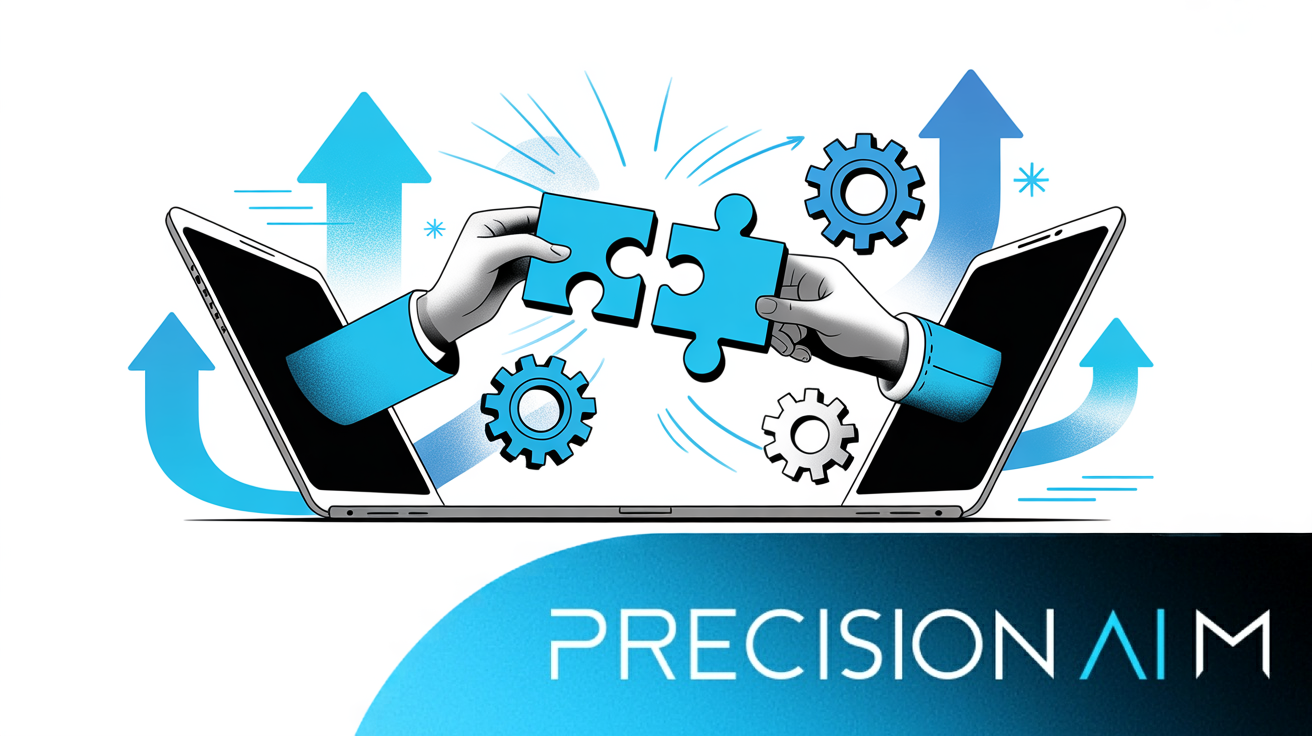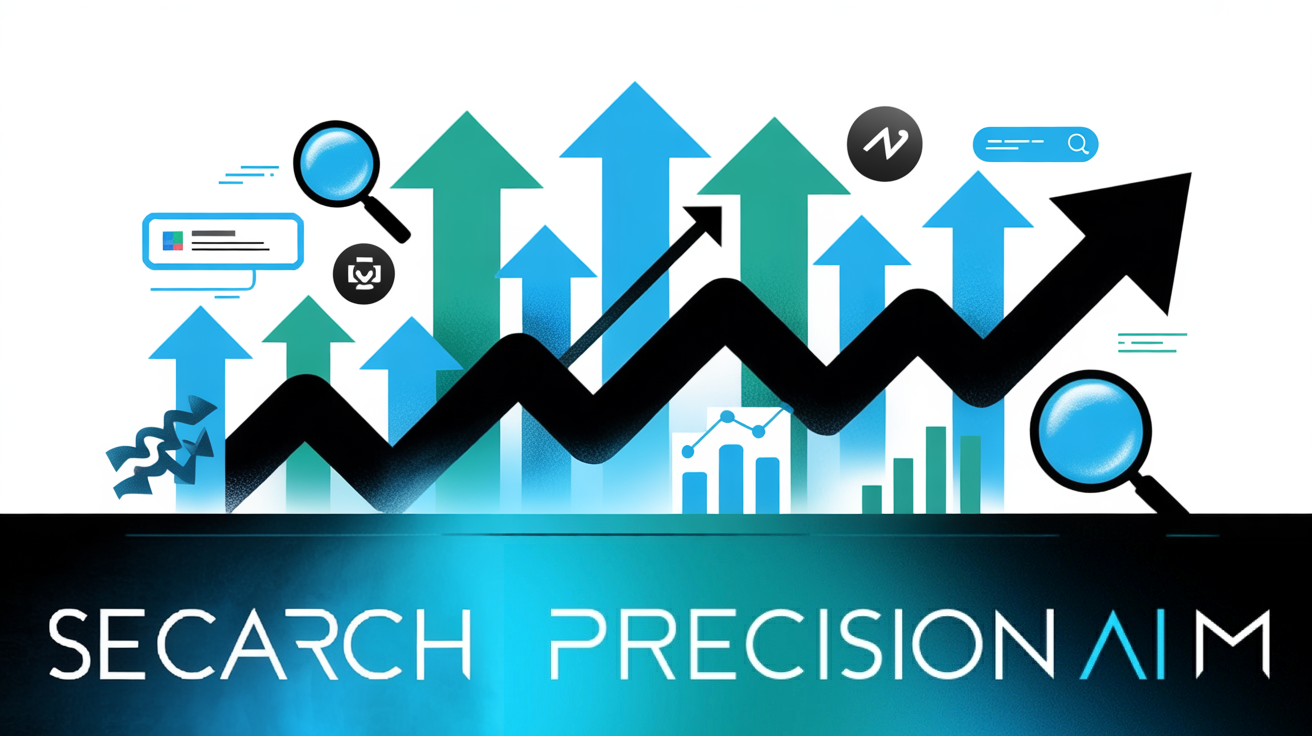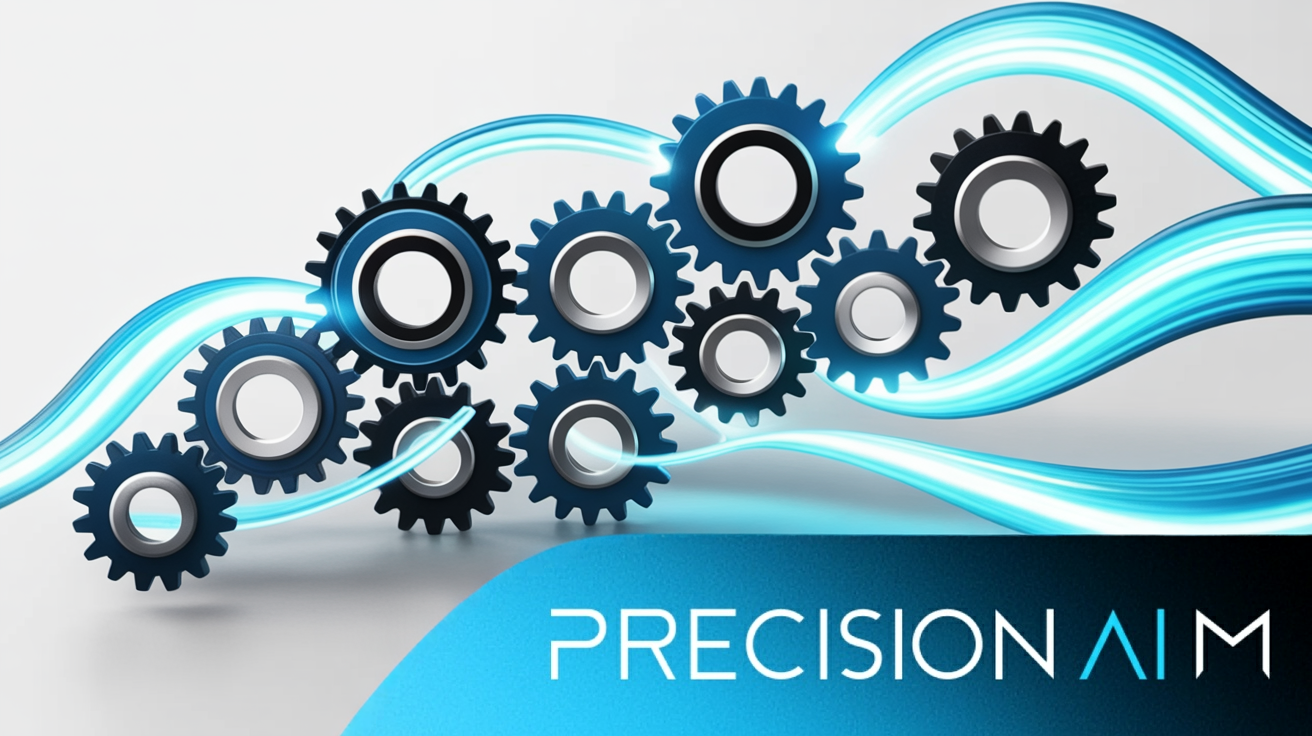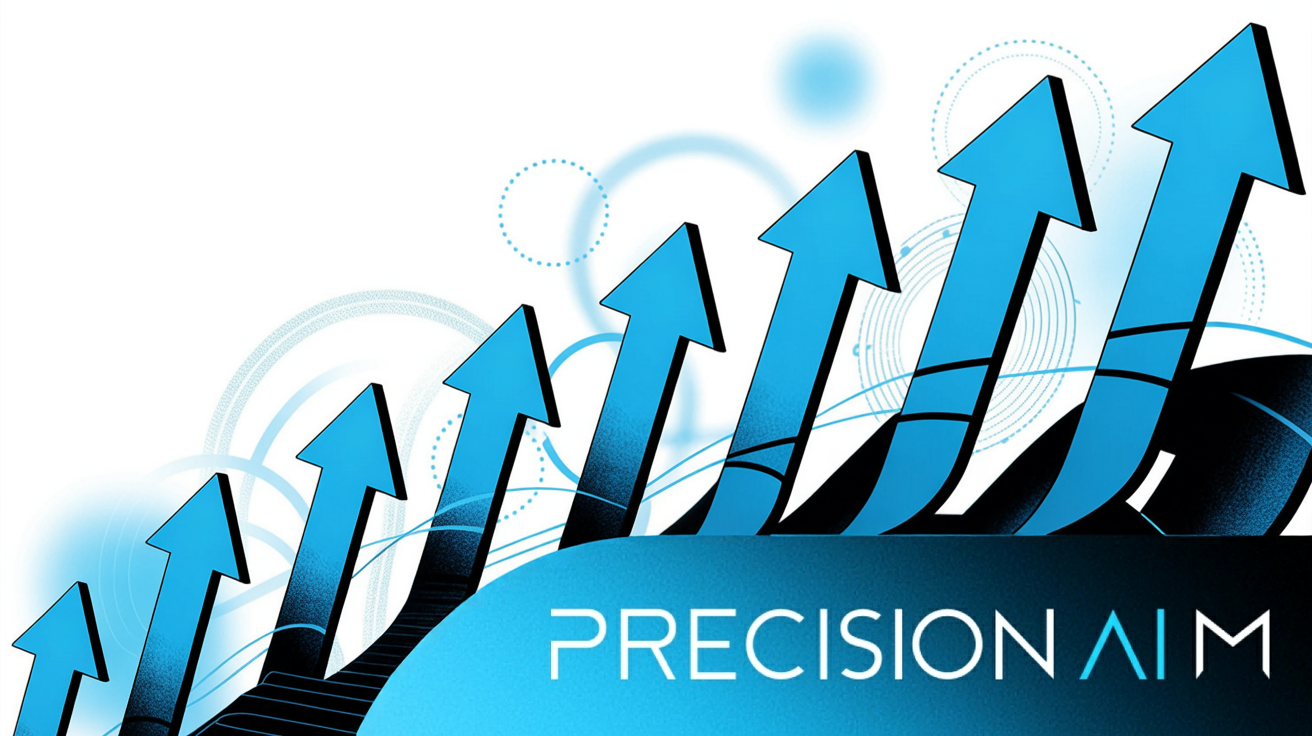Digital marketing demands more expertise and speed than ever, but building a strong in-house team isn’t always realistic for every business.
I’ve seen companies struggle with missed deadlines, rising costs, and gaps in specialist skills—especially when campaigns need to scale quickly or tap into new technology. Outsourcing is now a $25 billion market, and most organisations use external partners for at least some digital work.
In this article, I’ll break down what outsourcing digital marketing really means, the main models and service providers, and how responsibilities are shared. You’ll get a clear look at the benefits—like cost savings, faster launches, and access to advanced tools—as well as the risks, including brand control and data privacy.
I’ll also walk you through a practical decision framework, tips for choosing the right agency, onboarding steps, and a real-world case study. By the end, you’ll know exactly how to assess if outsourcing fits your business, avoid common mistakes, and set up campaigns for measurable success.
What does it mean to outsource digital marketing?
Understanding Digital Marketing Outsourcing
Let’s start with the basics—what is digital marketing outsourcing? It’s when a business turns to outside experts, agencies, or technology platforms to handle parts of its digital marketing. Think SEO, paid ads, content, analytics, or marketing automation—tasks normally managed inside now handed to specialists beyond the organisation.
Is this just about sending work overseas? Not really. Outsourcing focuses on getting the right expertise, efficiency, and flexibility, whether partners are local or global. It’s less about cheap labour and more about achieving top results with targeted skillsets.
Right now, this strategy is at the heart of many businesses. With the speed of digital changes and evolving customer behaviour, outsourcing has become more strategic than ever. In 2024, the digital marketing outsourcing market surpassed $25 billion, with most organisations involved at some level.
The digital marketing outsourcing market is projected to experience significant expansion, with a compound annual growth rate (CAGR) of 11.4%.
What’s driving this? It’s the demand for agility, specialist skills, and rapid execution in digital-first competition. Accessing external talent lets companies keep pace and adapt fast.
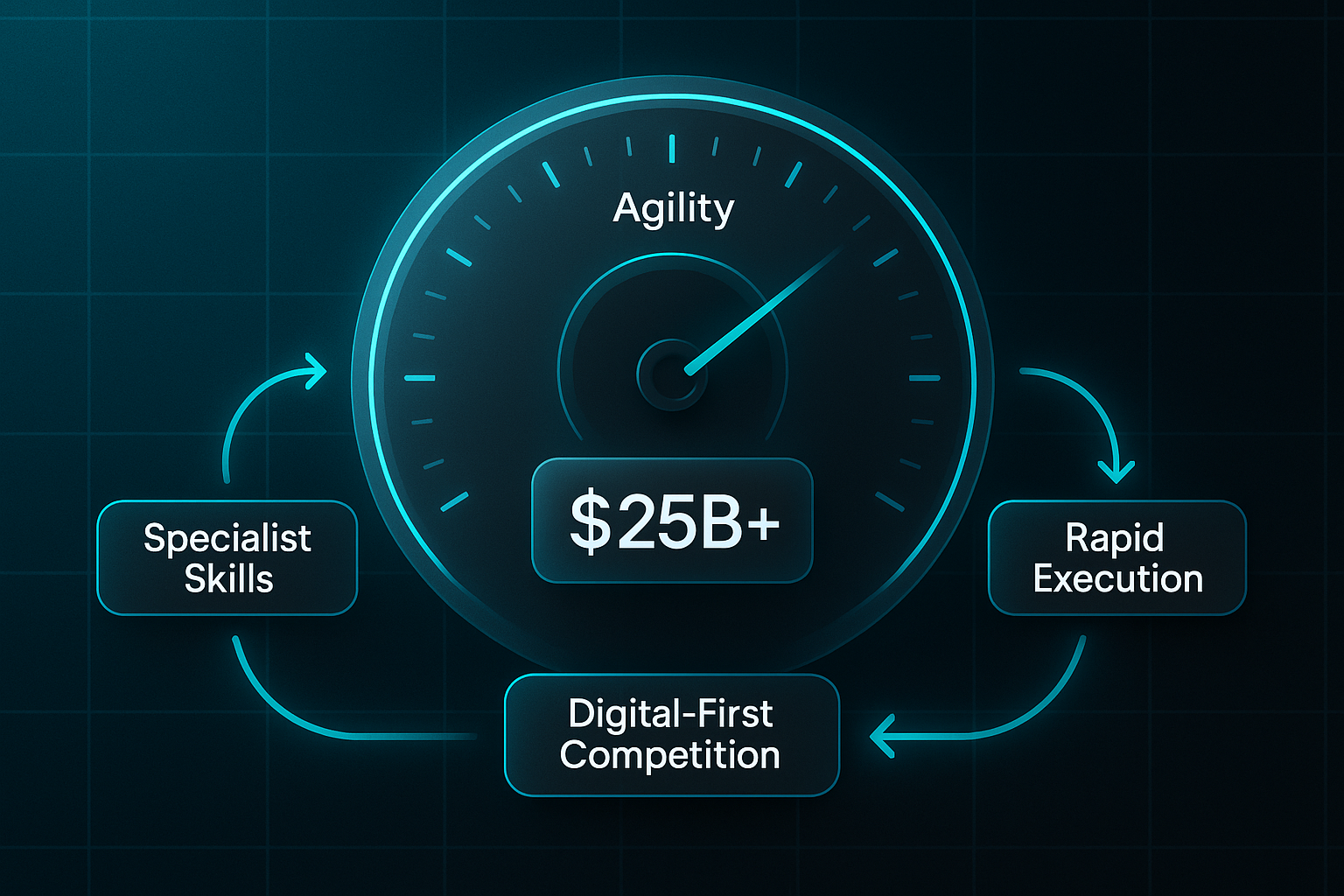
Why Outsourcing Matters for Businesses
Why do businesses consider outsourcing such a big deal? Several clear benefits emerge, and they keep organisations competitive.
- Specialist skills
Agencies and experts offer deep knowledge in fields like SEO or analytics, often outside the reach of in-house staff. - Scalability and responsiveness
External partners quickly scale campaigns up or down, matching market changes or new opportunities on the fly. - Efficient resource use
With less need for ongoing recruitment or training, internal teams can stay focused on strategy, not firefighting. - Impact of digital transformation
Cloud technology and remote platforms mean it’s now easier to work with global talent and advanced tools, no matter the business size.
Together, these advantages let companies stay strong amidst digital disruption.
Core Components and Key Models
Outsourced digital marketing isn’t just about delegating tasks—it’s a series of connected activities, all handled outside your office:
- Strategic planning and multi-channel management (SEO, email, social, paid)
- Campaign creation, from creative ideas to final assets
- Campaign optimisation and regular data-driven reporting
- Analytical dashboards for real-time insight
- Automation tools to streamline delivery
Partners are engaged in a few main ways:
- Retainer agreements
Ongoing support for developing and running campaigns - Project contracts
Defined, short-term marketing efforts - Subscription platforms
Regular, packaged solutions - Performance-based models
Payment based on agreed campaign results
The best arrangements always include clear KPIs and transparent reporting—so everyone knows what success looks like.

Types of Service Providers
Service providers come in all shapes and sizes to match business needs:
- Full-service agencies
Manage every digital marketing channel - Niche specialists
Focus on one thing, like paid ads or social media - Technology platforms
Deliver automation and data insights at scale - Freelancers
Tackle flexible, one-off assignments
Start-ups and small businesses often prefer freelancers or digital platforms, while larger firms may combine in-house strategy with outside execution. There’s no single “right” model—adaptability is key.
How Outsourcing Works Conceptually
Outsourcing, conceptually, is about sharing responsibility. The internal team sets broad strategy and upholds brand values, while partners oversee day-to-day execution—running campaigns, tweaking performance, and analysing efficacy. Shared dashboards and scheduled reviews keep everyone on the same page.

For example, one company might own its messaging but lean on an agency for analytics. Another might use freelancers for paid ads, or automate email via a subscription platform.
Common Challenges and Clarifications
Of course, some challenges are unavoidable. There’s always the risk of brand inconsistency or lapses in communication. And data privacy remains a real concern. But here’s the thing—outsourcing doesn’t mean giving up control. Businesses often use hybrid models to maintain oversight while harnessing fresh expertise.
Next Section Preview
Up next: a look at the direct benefits of digital marketing outsourcing—how organisations use external partners to access better skills, rapidly expand campaign scope, tap new technologies, and drive measurable marketing success.
What are the benefits of outsourcing digital marketing?
Leveraging specialist expertise and advanced capabilities
Outsourcing digital marketing gives you immediate access to strategists, SEO specialists, analytics pros, and creatives—no internal recruitment or training required.
Agencies and platforms employ tools like SEMrush and Ahrefs, offering deeper data, sharper analysis, automation, and instant optimisation. In-house teams rarely match this capability.
Your campaigns instantly benefit from up-to-date industry practices. The result is immediate expertise and streamlined marketing execution.
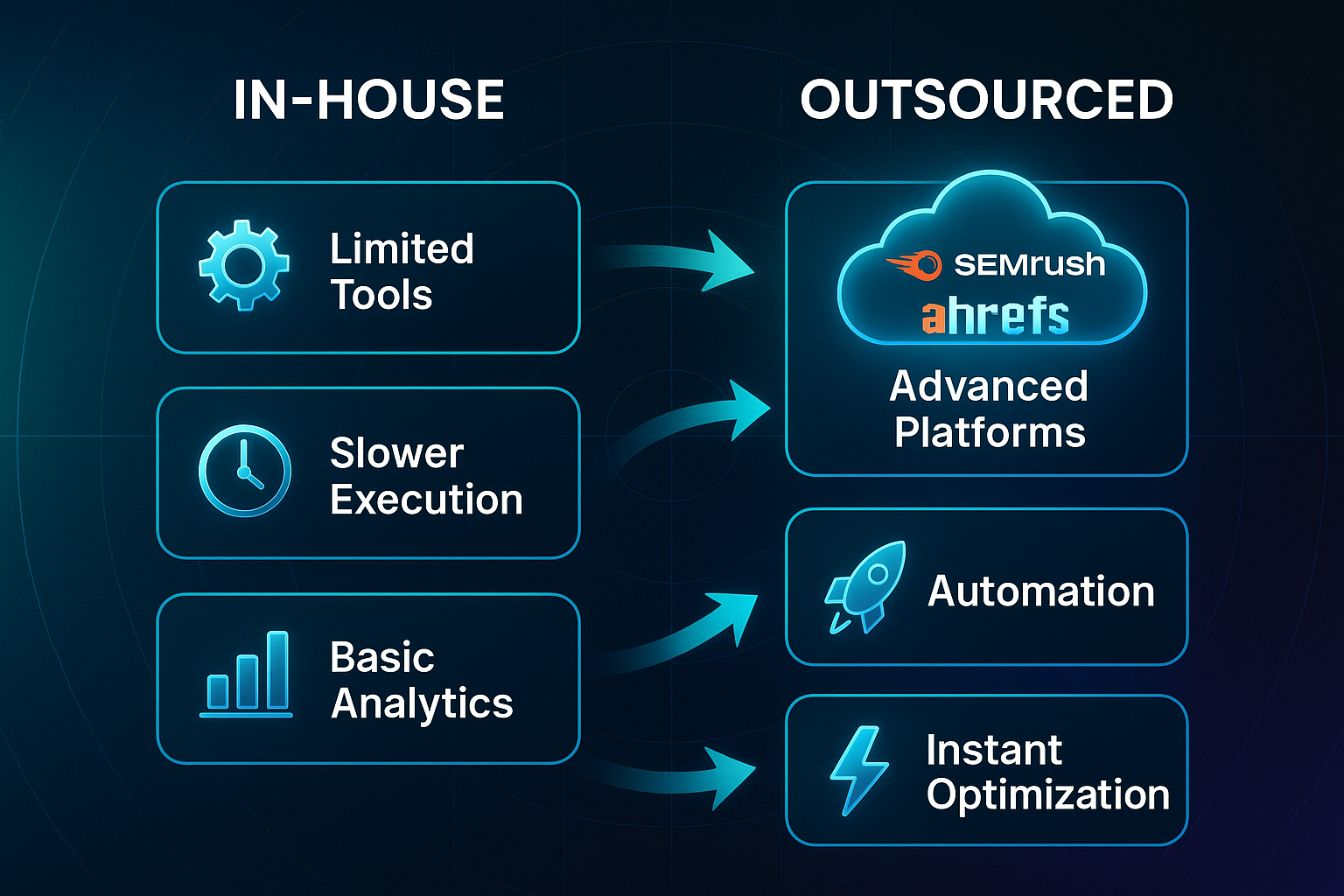
Accelerating campaign speed, scale, and flexibility
Speed is a major plus for outsourcing. Partners can take new campaigns live in as little as 30–45 days, versus months for most internal builds.
You can ramp marketing up or down to match business needs—no waiting for new hires or resourcing. Outsourced teams help you test fresh strategies or launch local SEO quickly, keeping your marketing agile.
Generating time and cost efficiency
With outsourcing, you only pay for what you actually need. No fixed salaries, benefits, or technology overhead.
Agencies usually bundle tools and talent into one clear cost, eliminating extra recruiting or licensing fees.
Most businesses outsourcing digital marketing spend 28–42% less annually than doing everything in-house. That’s budget you can put straight back into growth.
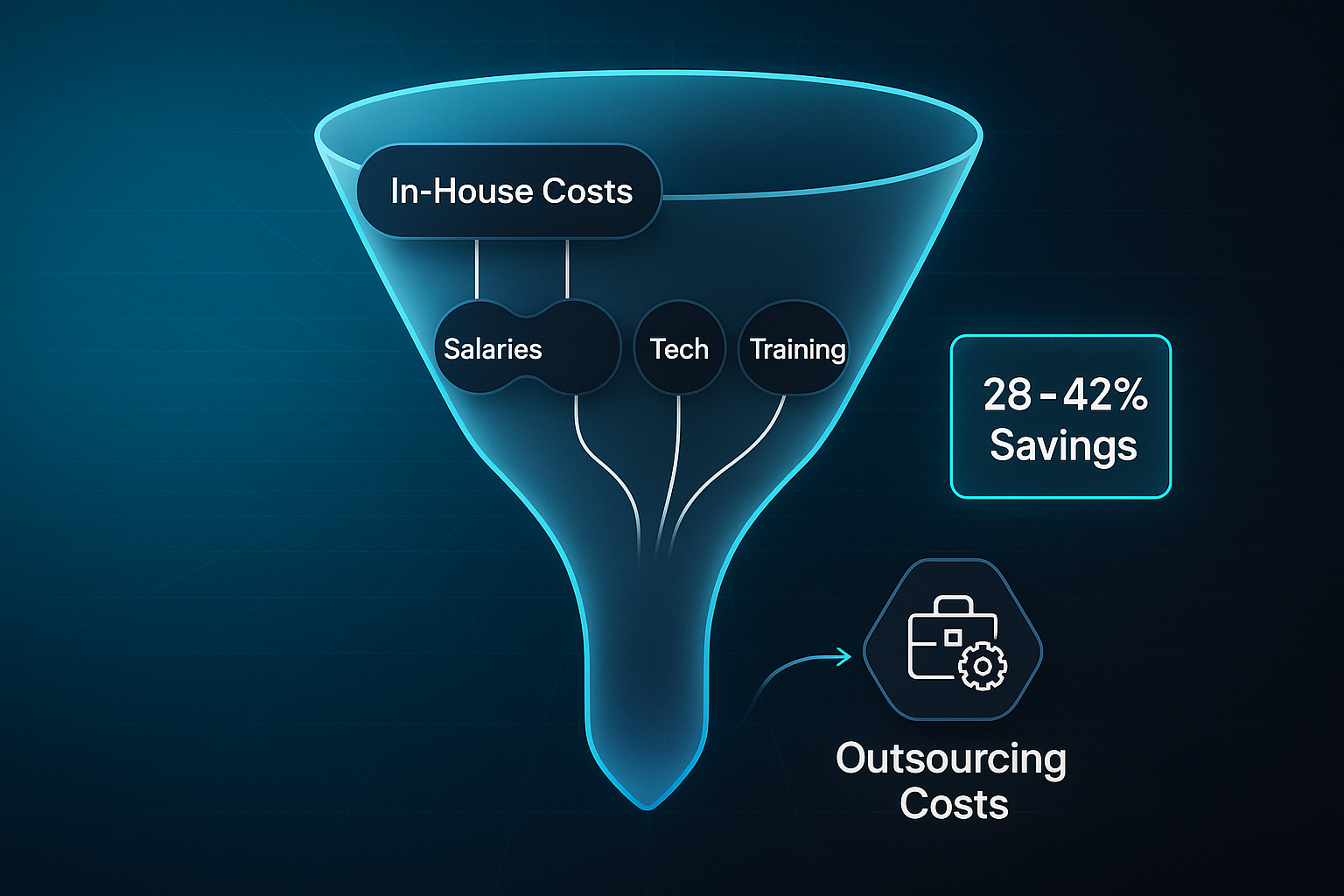
Delivering quality and measurable performance
Outsourcing brings clear frameworks and review cycles for consistent quality—along with real, measurable results.
Effective outsourced marketing hinges on a culture of performance, where every strategy and activity is tied to measurable outcomes.
You have live visibility via dashboards like Google Analytics or HubSpot. Regular feedback and quick adjustments mean your campaigns won’t drift off-track or waste spend.
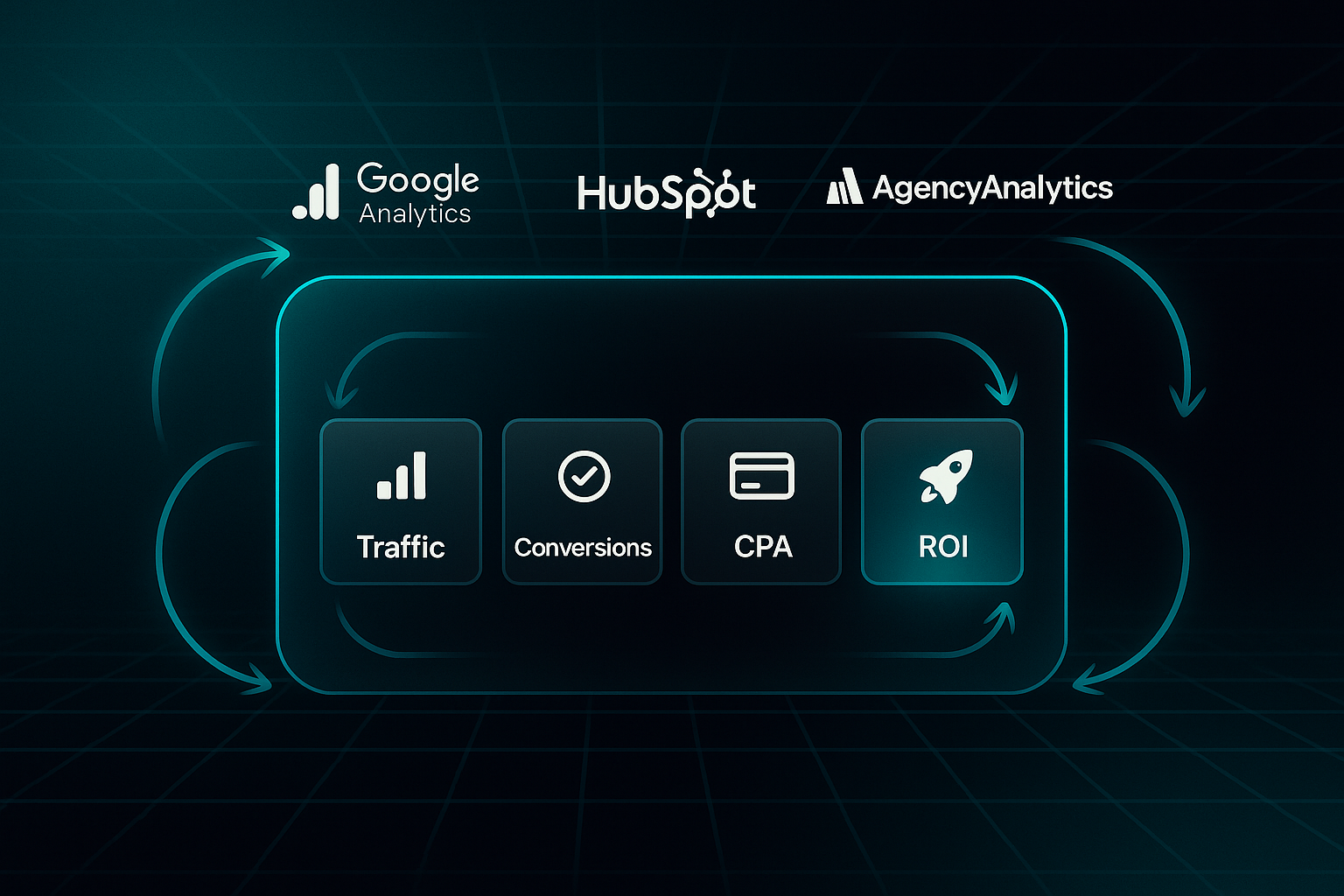
Operational example: Expert/AI hybrid managed SEO (SEOSwarm)
Here’s how it works with SEOSwarm, our hybrid solution. Setup is quick: after onboarding and a code snippet, SEOSwarm covers blog publishing, research, optimisation, and reporting—combining multi-agent AI and expert oversight.

AI drives content creation and research, while humans manage strategy and sign-off.

SMEs usually see 10–30% higher organic traffic in two to three months, content time cut by 43%, and up to 82% better conversion rates (2023–2024 benchmarks). Pricing is tailored for you.
| Model | Setup Speed (days) | Client Involvement (hours/month) | Organic Traffic Growth (%) | Conversion Rate Change (%) | Resource Cost Saving (%) |
|---|---|---|---|---|---|
| In-house team | 60–120 | 30–40 | 2–10 | 5–12 | — |
| Traditional agency | 30–45 | 8–16 | 6–18 | 11–23 | 10–20 |
| SEOSwarm expert/AI hybrid | 10–15 | 2–5 | 10–30 | 21–82 | 28–43 |
These numbers show SEOSwarm excels for setup speed, minimal effort, and strong SME results. Resource savings over agency or in-house models are substantial.

AI-Powered
SEO Content Strategy
See the AI platform that's replacing entire content teams
(with better results).

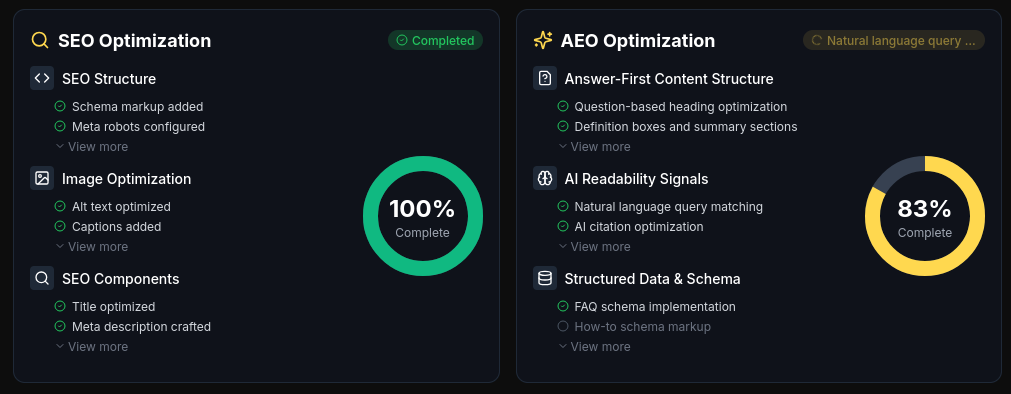
Validating results and avoiding mistakes
To ensure your investment works, set clear KPIs like traffic and ROI at the outset and log your current metrics.
Require transparent reporting and live dashboards, then benchmark outcomes to targets. If results lag, ask for changes.
Steer clear of vague objectives, provider mismatch, silent communication gaps, or hidden fees. Regular audits and feedback keep things on track.
Tailoring your approach: model fit
Which outsourcing model fits you best? It depends on size and goals.
Large enterprises may choose in-house for control. Mid-sized businesses often prefer agencies—to scale fast and keep brands aligned. Startups and SMEs usually get the best from expert/AI hybrids like SEOSwarm, where automation and speed are top priorities.

Blended approaches—internal strategy, outsourced execution—can strike a balance.
| Engagement Model | Best Fit | Resource Commitment | Speed to Launch | Tech & Automation Depth |
|---|---|---|---|---|
| In-house | Large enterprises—control, complex needs | High | Slow | Variable |
| Traditional agency | Mid-size—scaling, branding | Medium | Moderate | Standard |
| SEOSwarm expert/AI hybrid | Startups/SMEs—speed, automation | Low | Fast | High |
For SMEs aiming to move quickly, the hybrid pathway often means faster ROI and less admin. Enterprises with unique needs may still favour in-house for oversight.

Prerequisites and integration safety
Before starting, confirm admin access, reporting tools, and team buy-in. Test integrations in a safe environment and keep backups to protect your data.
Special considerations
Extra diligence is essential for regulated industries, luxury brands, or bespoke tech stacks. Vet suppliers, use approval processes, and monitor results carefully to protect brand and data integrity.
Next section preview
Next, we’ll explore potential downsides of outsourcing—brand risk, communication issues, quality control, privacy challenges, partner reliance, and hidden costs.
What are the potential drawbacks of outsourcing digital marketing?
Navigating Brand and Communication Risks
Let’s start with one of the trickier risks: brand nuance loss. When you put your marketing in someone else’s hands, subtle messaging, cultural cues, and your unique company voice can easily slip away.
Plenty of big UK retailers and international SaaS companies have had to recall or revise campaigns due to poor localisation or message misalignment—usually in the early stages when agencies haven’t yet absorbed your brand’s personality.
Agencies generally spend 31–40 days onboarding. This means getting to grips with brand guidelines and messaging priorities, but also approval processes and compliance rules.
Mapped onboarding is key—workshops, live Q&As, and an appointed owner for every step. It’s all about fast alignment and reducing risk.

Communication gaps are another classic issue. Time zone differences, language barriers, or incompatible tools can slow things down. The fix? Build routines: weekly kickoff calls, after-action reviews, tracked with a shared system. This keeps feedback timely and confusion to a minimum.
Safeguarding Quality and Data Control
Quality and data control matter deeply. Set up regular quality assurance checkpoints—monthly or bi-weekly—and ask agencies to document sign-offs and benchmarks for every deliverable.
Regulated sectors should insist on compliance checks; suspend campaigns immediately if standards slip.
Data privacy is crucial. Contracts should call out GDPR (General Data Protection Regulation), CCPA (California Consumer Privacy Act), or similar standards, with explicit procedures for handling data and platform access.
Permission-based sharing and regular reviews help maintain control. Platforms such as Asana, HubSpot, and Google Analytics are handy for monitoring vendor access and running audits.
Project management systems—Asana, Trello, Monday.com—pull double duty: tracking tasks and documenting compliance to help spot issues and ensure accountability.
Managing Dependency, Costs, and Operational Limits
Dependency grows if only external partners have the creative ideas or critical campaign knowledge. To stay in control, schedule quarterly knowledge-transfer sessions and annual capability reviews so essential documentation stays in-house.
Cost overruns can sneak up via retainers, audits, or hidden add-ons. Most agency retainers start at $1,000–$1,500/month, with full-service contracts going over $10,000/month. Analytics or reporting shifts often trigger surprise costs.
Control costs with monthly and quarterly spending limits, and confirm written approval for scope or last-minute changes.
Itemised invoices and dashboard monitoring let you track spend closely. Flag anything that’s more than 10% over projected—review before paying more.
Quality Control and Communication Protocols
Structured onboarding solves a lot of potential problems. Use a standard seven-step workflow: contract signature, secure tool access, brand Q&A, interim audits, and sign-off before launch. Make sure every phase has a clear owner.
Cross-team platforms like Asana, Trello, or Monday.com (£6–£25/user/month) deliver transparency—deadlines, reviews, and deliverables in plain sight. Demand live reporting with Google Analytics 4, AgencyAnalytics, or HubSpot. Watch traffic, conversions, CPL (Cost Per Lead), and ROI (Return on Investment). Auto-alerts flag issues early.
Weekly meetings during onboarding pay off; switch to monthly and quarterly reviews as projects mature. Regulated campaigns should include a compliance lead.
Prerequisite Checklist for Outsourcing Success
Ready to outsource? Prepare credentials—analytics, CRM, CMS, and ads, lock down contracts covering IP, privacy, and data, select workflow tools, pick onboarding and review leads, and define KPIs and budget limits.
If you operate in a regulated sector, add incident protocols and check provider credentials before signing up.
Troubleshooting and Validation: Maintaining Control
A table like this makes troubleshooting simple:
| Issue | Diagnosis | Immediate Remedy |
|---|---|---|
| Scope creep | Deliverables exceed brief | Update brief, sign addendum before new work |
| Delayed feedback | Slow reviews or sign-off | Book regular standups or use live review tools |
| QA breakdown | Quality or compliance failures | Follow QA checklist and review cycle |
| Rising costs | Spend >10% over plan | Audit invoices, halt sign-off for extra spend |
Track KPIs—conversion, CPL, lead quality, ROI—through dashboards, milestone reviews, and signed quarterly or annual results.
Special Considerations for Edge Cases
Outsourcing for regulated, luxury, or international campaigns needs stricter controls. Prepare with legal and compliance reviews, segment platform access, and hold regular executive audits.
Clear backup and archival policies protect against brand and data risks if things go wrong.
Next Section Preview
Next, we’ll lay out a decision-making framework for outsourcing: balancing resources, budget, control, regulatory needs, and how to pick the best-fit provider for your goals.
How should you decide if outsourcing digital marketing is right for your business?
Auditing Internal Capabilities and Readiness for Outsourcing
So, how do you know if your business is really ready for outsourcing digital marketing? Start by mapping out all your marketing activities—SEO, content, paid ads, analytics, and social campaigns—using project management tools like Asana, Monday.com, or Trello. Assign ownership, log weekly hours, and look for missed deadlines or campaign backlogs.
Examine your team’s skills. Are they well-versed in Google Analytics Individual Qualification, SEMrush SEO, or HubSpot Content Marketing? Check where skills line up—if people spend too much time on unfamiliar tasks, or projects regularly hit bottlenecks, outsourcing becomes a smart option.
Now, let’s talk figures. List every staff salary, benefit, tech subscription, training, and management overhead. For UK SMEs, five core team members at full-time equivalent (FTE: Full-Time Equivalent) might cost around £210k/year; tech stack about £38k; training and certification £7k; overhead £20k. To compare, agency proposals via a Request for Proposal (RFP: Request for Proposal) typically include retainer fees (£120k–£160k), integration (£10k–£15k), and reporting (£3k–£5k). Recent surveys show agencies charge a 20–30% premium, but could deliver 25–40% higher engagement in just six months.
Here’s a quick overview of annual SME cost comparisons:
| Cost Component | In-House (Annual) | Agency Proposal (Annual) | 2024 Note |
|---|---|---|---|
| Staff Salaries/Benefits | £210k (5 FTEs) | N/A | Average for SME team |
| Tech Stack | £38k | £10k–£15k (integration) | Agency may use proprietary tools |
| Training/Certification | £7k | £0–£3k | Included for agency staff |
| Overhead | £20k | N/A | Office, compliance, management |
| Agency Fees | N/A | £120k–£160k | Retainer/project, 20–30% premium |
| Performance Reviews | £2k | £3k–£5k | Quarterly audits/reporting |
It’s important to note—not every function should be outsourced. Make a clear list of activities involving sensitive data, especially PII (information that can identify a person), customer records, or highly regulated analytics. Consult with legal for industries like finance, healthcare, or tech. Agencies must sign a Non-Disclosure Agreement (NDA: legal contract protecting confidential information) and only be given granular system access.
- Validation checklist
Compare hours logged to those planned, review your skills inventory, model costs side by side, and work with legal on high-risk areas. - Mistake prevention
Don’t outsource without a thorough audit or clear risk analysis—or without considering hidden onboarding costs.
Pull all findings into a leadership summary, including gaps, costs, and critical risks.
Aligning Strategic Goals and Assessing Outsourcing Fit
Next, rate each marketing initiative by its complexity and the speed you need. Create a simple campaign matrix—some areas will clearly move faster with agency help. Outsourcing accelerates time-sensitive projects, with event marketing campaigns in 2024 seeing go-live times 40% faster than in-house efforts.
Demand compliance credentials from agencies—GDPR, CCPA, ISO 27001—plus signed NDAs. Always start with a pilot campaign, measure results, and keep tabs with regular reporting.
- Common pitfalls to avoid
Picking agencies only on price, forgetting integration with sales or marketing, or skipping legal advice before sharing confidential data.
Applying a Decision Matrix and Scorecard
Build a weighted scorecard—factor in expertise, costs, process fit, scalability, launch speed, confidentiality, creativity, responsiveness, and your need for control. Assign higher weights to regulated industries for control, or to innovation-led firms for creativity.
Gather real data—use payroll details, agency RFPs, timeline histories, and manager feedback, and review collaboratively. Test your decision with a pilot project, revisiting your scorecard as the business evolves. Watch for red flags: missing cost categories, skipping pilots, or outdated priorities.
Next Section Preview
Section 5 dives into selecting your partner—what to look for, checking references, ensuring tech compatibility, trial contracts, and smart questions for discovery.
How to choose the right digital marketing partner
Defining Campaign Objectives and Performance Expectations
Start with clear, measurable objectives—like “increase qualified leads by 20% in Q3”—so agencies know exactly what you’re after.
The foundation of successful outsourced marketing lies in results-focused campaigns designed to drive measurable growth.
Tie these goals to KPIs you’ll track in Google Analytics 4, HubSpot, SEMrush, or AgencyAnalytics.
Share previous campaign reports, competitor benchmarks, and brand guidelines. The more specific you are, the better proposals you'll get.
Assessing Agencies: Portfolio, References, and Sector Fit
Study agency portfolios for related projects and real before-and-after numbers.
When you call references, don’t just tick a box—ask about consistency, transparency, and problem-solving under pressure.
Agencies with genuine sector experience usually get up to speed faster and produce better outcomes.
Platform and Technology Integration
Make sure the agency works with your marketing stack: Google Analytics 4, HubSpot, SEMrush, AgencyAnalytics, or your legacy CRM.
See a live dashboard demo—with single sign-on (SSO), two-factor authentication (2FA), and audit logs. Request trial access first.
UK SME onboarding and integration fees typically run £1,200–£4,500. Compare offers directly.
Team, Certification, and Onboarding
Request a team chart and proof of certifications (Google, Microsoft, Meta).
Onboarding must include asset handoff, permissions, NDA (Non-Disclosure Agreement: protects confidential info), and compliance checks. Set up shared storage (Dropbox, Google Drive) for easy collaboration.
Costs, Contracts, and Pilots
Expect monthly retainers (£2,500–£15,000), pilots (£4,000–£9,000 for 1–3 months), onboarding (£1,200–£5,000), and hourly rates (£60–£220).
Choose a fixed-price pilot to test the fit before long-term deals. Contracts should clarify deliverables, deadlines, and ownership of data and assets.
Communication, Transparency, and Reporting
Trial periods reveal a lot. Are meetings prompt? Do tools like Asana, Slack, or Teams keep everyone informed?
Dashboards must show live status and audit logs, and you’ll want clear contacts with 24-hour escalation for urgent issues.
Validating Agencies: Pilots and Performance Review
Use pilots to scrutinise performance—track cost per acquisition (CPA), conversion rates, analytics setup, and secure asset handoff.
Scoring agencies with a simple scorecard, then holding review meetings, makes it easier to spot your best option. Back up assets and check compliance before signing.
Discovery Questions and Red Flags
- KPI translation
How do you make strategic goals actionable? - Tech and AI insight
Which platforms drive your analytics? - Onboarding approach
What does your onboarding look like? - Data security protocols
How is my data secured (compliance, SSO/2FA)?
The main red flags? Weak case studies, poor references, hidden dashboards, unclear onboarding, or vague asset terms.
Troubleshooting Selection Issues
If you’re missing dashboard access or pilots underperform, push for a live demo or a quick fix. Weak communication? Clarify a single contact and use agreed tools.
For compliance or handoff gaps, review contract terms and be ready to pivot if the agency can’t deliver.
Implementation Checklist and Validation Table
- Define campaign goals
Objectives, KPIs - Review portfolio/references
Track record - Test dashboards
Live demo - Check team/certifications
Expertise - Agree on pilots and costs
Fixed-price pilot - Approve onboarding
Assets, NDA - Backup/data transfer
Archiving - Sign contract
Service levels, deadlines
| Checkpoint | Pass Criteria |
|---|---|
| Dashboard access | Demo and permissions validated |
| Positive references | Client feedback |
| Pilot targets met | CPA/conversion benchmarks |
| Compliance | NDA/certs |
| Asset handoff | Secure transfer |
Frequent milestone checks reduce risk and improve campaign results.
Next Section Preview
Now you’re ready for onboarding, smooth workflows, better reporting, and collaboration tips for long-term digital marketing success.
What should you expect when you outsource digital marketing? (Onboarding and ongoing workflows)
Mapping the Onboarding Journey: Stages, Deliverables, and Validation
So, what does the process actually look like when you hand your digital marketing over to an agency? It starts with a clearly structured onboarding plan. For UK SMEs and mid-sized firms, this typically takes about 45–60 days—not something to rush, as each stage lays the groundwork for a successful campaign.

You’ll move through a sequence of steps, each one with its own deliverables and checkpoints:
- Contract and NDA (Days 1–3)
Legal alignment kicks off the partnership, with signed contracts and Non-Disclosure Agreements to protect your scope and intellectual property. - Discovery and questionnaires (Days 3–7)
The agency collects your business goals, marketing history, asset library, and campaign priorities using detailed forms and data sharing. - Kickoff meeting (Days 5–7)
Everyone meets the team, validates platform access, sets key performance indicators (KPIs), and agrees on reporting cadence and contact points. - Website/assets audit (Days 7–14)
They’ll audit your site and marketing accounts, ensuring assets are in order and analytics (think GA4) are tracking properly. - Strategy sign-off (Days 14–21)
Here, the plan gets reviewed and approved—covering channels, a schedule, and core KPIs so there’s no mystery about what success looks like. - Campaign setup (Days 21–35)
New ad accounts are created, dashboards like AgencyAnalytics configured, and integrations get implemented. All asset approvals and credential checks happen here. - Analytics validation (Days 35–45)
This is when conversions are tested, reporting platforms (such as Supermetrics and Whatagraph) are connected, and data import is confirmed. - Go live and initial review (Days 45–60)
Baseline reports confirm tracking works, first campaign results are reviewed, and systems are checked for any hiccups.
Throughout onboarding, keep documentation close—signed contracts, brand guidelines, asset libraries, validated logins, onboarding questionnaires, and old campaign reports. Validate every step before moving on. If logins or KPIs are missing, that’s a top source of delay. An onboarding checklist and double-verification system keep things on track. Costs for UK SMEs usually start at £1,200–£4,500, with ongoing retainers between £2,500–£15,000 per month for continuous management and optimisation.
Setting Up Live Campaign Workflows: Reporting, Meetings, and Validation
Once onboarding wraps up, your day-to-day workflow begins. Here’s the rhythm you’ll see:
- Weekly reports for new campaigns
Monitor initial KPIs, conversions, and budgets. - Monthly reports for ongoing campaigns
Detail traffic, conversion rates, CPA (Cost Per Acquisition), ROAS, and ROI. - Quarterly reviews
Re-examine strategy, budget, and long-term goals.
You’ll rely on dashboards like AgencyAnalytics, TapClicks, Supermetrics, or Whatagraph for live stats and attribution. Always test dashboards for up-to-date metrics. If anything is missing or not tracking, ask for fixes before giving a green light to further spend.
Structuring Meetings and Feedback Loops for Success
Meetings anchor campaign success. Agendas should run through a wins/losses summary, KPI reviews, tactical advice, and clear next steps. All assignments are tracked and notes shared using Notion or Google Docs. Regular review cycles mean feedback gets actioned and progress never stalls.
Troubleshooting, Preventing Mistakes, and Ensuring Control
Want fewer headaches? Make sure all credentials are validated, dashboards actually track what you need, and there’s a clear escalation path for urgent problems. Password managers and backups add a layer of security, while SLA-based response times and audit logs ensure accountability.
Managing Edge Cases: Regulated and Complex Scenarios
For regulated industries, expect a longer onboarding—add up to two weeks. You’ll also need extra compliance checks and sector-specific contracts. Firms with complex tech stacks should run joint audits and integration tests, always with rollback plans and staged launches in case disruptions crop up.
Next Section Preview
Next, you’ll see a real-world case study—following an SME through onboarding, launch, and the upswing in traffic, engagement, and conversions that outsourcing made possible.
Real-world example: How outsourcing marketing transformed Sunrise Bakery
Business Background: Identifying Bottlenecks and Triggers
Let’s take Sunrise Bakery—a family-owned shop in Los Angeles that hit a digital wall early in 2024.
Their in-house team could not move the needle: website visits hovered at 110 per week, and online orders made up less than 17% of monthly revenue. Meanwhile, local competitors jumped ahead on search and social channels, exposing Sunrise’s patchy digital strategy and frequent missed deadlines.
To start outsourcing, they organised admin access to their CMS (Content Management System), analytics, business listings, and ad accounts. They centralised brand assets and secured a fresh NDA (Non-Disclosure Agreement) for compliance.
Selecting and Onboarding an Agency
They prioritised agencies with proven local results in food/retail and strong expertise across SEO (Search Engine Optimisation), paid media, and onboarding. After reviewing portfolios and checking references, Sunrise signed up for a $1,000 onboarding fee and a $2,500/month retainer.
Onboarding began with a kickoff meeting to set contacts, responsibilities, and firm KPIs (Key Performance Indicators)—like doubling orders and breaking into Google’s top three for ‘bakery LA’. Brand interviews and asset inventories followed, safeguarding authenticity and smooth campaign assembly.
Campaign Execution and Validation
Campaign work kicked off with revamped Google Business Profile, Bing, and Yelp listings, bolstered by sharp visuals and updated descriptions. They then launched geo-targeted Google and Facebook ads with a $1,200/month media budget, timing everything alongside new product releases and community events.
The team scheduled weekly blog posts, daily Instagram, and collaborated with local micro-influencers ($250–$500 per post), featuring customer stories and behind-the-scenes content. Success was measured by key stats: site traffic, conversions, social engagement, and ad click-through rates above 2%. Bi-weekly reviews fixed any issues, with compliance checks and asset backups required before each push.
Troubleshooting and Risk Controls
- Low Instagram engagement
Moved from stock images to influencer and behind-the-scenes content—engagement jumped 38%, and online orders rose 22%. - Ad policy issue
Paused, rewrote, and resubmitted content the same day; zero downtime. - Competitor complaint
Updated ad copy instantly to meet standards and avoid disruption.
They enforced permission checklists, live dashboards to watch KPIs, daily data backups, and staged releases to catch errors before rollout.
Results and Actionable Learnings
After three months, Sunrise Bakery achieved a 110% increase in website visits, 400% growth in social engagement, top-three ranking for “Best bakery LA”, online orders up 55%, and a 40% rise in in-store sales (tracked through promo codes and POS surveys).
Solid routines—frequent reviews, asset handoff, and tight feedback—ensured repeatable, sustainable marketing wins with built-in protection.
Your Competitors Are Using AI. Are You?
We help companies transition into the new age of marketing.

Ready for the next step? Let’s see how agencies tap automation and AI to help you launch campaigns faster and capture deeper insights.
How agencies use automation and AI tools (with decision frameworks and troubleshooting)
Let’s step inside the engine room of digital marketing today: automation and AI tools. Agencies weave these platforms into every campaign—from email and social to ads, content, and analytics—shrinking manual tasks and unlocking faster, more reliable results.
Core Areas and Tools
A smart agency toolkit hits every digital front. Mailchimp and Salesforce Marketing Cloud automate personalisation, drip campaigns, and A/B testing for email, halving set-up time and often driving a 30% jump in open rates.
For social media, Hootsuite and Buffer automate post scheduling and replies, so one person can do what once took a team.
Content and SEO get a boost from Surfer SEO Max and Jasper; these platforms automate research and drafting so teams publish four times more, with 35–50% faster ranking boosts.
Paid ads automation—from HubSpot or WordStream—handles real-time targeting, ad rotation, and budget pacing. This typically cuts wasted spend by 35–60%. On reporting, Swydo and AgencyAnalytics build live dashboards and send white-labelled reports, dropping monthly analytics work by 70%.
Platform Selection: A Five-Step Framework
Picking the best automation tool isn’t about the flashiest features. Try this five-step process:
- Scope and budget
Define exactly what needs automating and set your ceiling. - Compatibility check
Will it play nicely with your CRM (Customer Relationship Management) or analytics (such as HubSpot, GA4)? - Features audit
Prioritise must-haves—think A/B testing, API access, or compliance. - Pilot testing
Trial with a real campaign and measure the time, accuracy, and dashboards. - Reliability review
Check error logs, get support feedback, and look for client case studies.
For advanced scaling or analytics, Salesforce or AgencyAnalytics may be your edge.
The Real Impact
So, what’s the tangible gain? Agencies typically save 2–3 hours per person daily, cut reporting by 70%, and double content output—all while reducing errors. Approval and feedback cycles shorten, with everyone operating from a shared, always-updated dashboard.
Troubleshooting, Backups, and Edge Cases
No tool is fire-and-forget. If metrics stall or dashboards glitch, re-sync integrations, audit, and keep regular backups—Mailchimp and HubSpot make this easy. Always sandbox big changes, keep credential security tight, and run quarterly test restores to protect against loss.
For regulated or complex businesses, enable compliance modules, schedule dual sign-offs, and insist on executive reviews for new rollouts.
AI Automations: Practical Outcomes
Platforms like AI Automations automate triggers, segmentation, and reporting, cutting admin work by 50% and slashing manual errors. The upshot? Faster feedback, crisper campaign pivots, and robust compliance.
Next: let’s tackle common outsourcing mistakes—and the routines that keep digital campaigns steady.
Common mistakes to avoid when outsourcing digital marketing
Critical Mistakes: Onboarding, Agency Fit, and Accountability
Outsourcing can fuel real gains for SMEs if you manage budgets of $3,000–$20,000/month and run with a small 2–6 FTE (full-time employees) team. But missing key steps puts resources and results at risk. The costliest mistakes? Poor onboarding, vague goals, mismatched agency fit, and lax data control.
A frequent trap is skipping SMART (Specific, Measurable, Achievable, Relevant, Time-bound) objectives. Without them, you risk missing 30% of your targets and incurring $1,000–$3,000 in rework. Prevent this: agree written KPIs (Key Performance Indicators) with a tool like Asana or Monday.com ($10–$19/user/month), nominate a point person on both sides, and confirm sign-off in the project platform. This upfront structure cuts missed deliverables by 30% and speeds campaigns by 25%.
Agency mismatch causes delays—up to 25–50% extra time if you skip reference or onboarding steps. Always insist on at least two sector-specific references and a workshop that covers brand, asset transfer, and voice guidelines. Allocate 2–4 hours to prep; workshops typically cost $500–$2,000. If agencies can’t show sector fit or solid onboarding, limit them to a paid pilot or move on.
Admin access and backup routines are critical. Assets disappear or get locked if you don’t validate logins—use LastPass or 1Password ($7–$8/user/month). This check only needs 1–2 hours but averts $1,000–$7,500 in recovery costs. Always assign ownership and test credentials before launch.
Locked dashboards or missing reports trace back to skipped validation. Troubleshoot by double-checking admin access and dashboard owners and auditing backup routines.
Timelines, Pilots, and Reporting
Don’t assume fast ROI. Most outsourced campaigns need a 3–6 month ramp, especially for SEO. Paid pilots ($2,500–$10,000) run 3–6 weeks and need clear, written KPIs. Vet results before long-term contracts.
Bi-weekly reporting with AgencyAnalytics or Looker Studio ($79–$479/month; some free) is vital. Check dashboards monthly; escalate variances of 20% or more—can save $5,000 per incident.
Secure Exit and Pre-Launch Checklist
Include asset logs, legal handoff, and backup protocols in every contract. Assign an owner for checks—security reviews (£500–£2,500) are worth it. Regulated or global projects may mean 50–100% higher cost and longer onboarding.
Before launch, self-audit: admin access, contracts, team roles, onboarding Q&A, backups. Score 0–2 on each, aim for at least 10 of 12. Miss a step and risk $1,000–$5,000 in rework.
Next up—a guided framework to assess readiness, bridge gaps, and pilot agencies with confidence.
Is outsourcing digital marketing right for you? (Decision and action checklist)
Self-Audit: Assessing Readiness and Internal Capabilities
Before you make any decisions about outsourcing, start by defining your main objectives—maybe it’s to increase qualified leads by 30% in six months or to cut your campaign development time in half.
Now, create a skills matrix for your team. Take a close look at in-house strengths—SEO (Search Engine Optimisation), paid ads, analytics, automation, content—and pinpoint what’s missing. Which platforms, like HubSpot or Google Analytics, aren’t being used to their full potential, or not used at all?
Don’t forget to log operational bottlenecks. Missed deadlines, constant backlogs, and heavy workloads are clues that your internal capacity could be holding your business back.
Next, tally up all those hidden costs—salaries, training, subscriptions, management hours—and compare that number with agency proposals for similar campaign goals. Since most agencies launch projects 2–4 times faster, that speed can make all the difference when you’ve got tight deadlines or a market that’s always shifting.
Action Framework: Steps for Decision and Implementation
Narrow your choices down to agencies or platforms with sector experience, regulatory compliance (UK GDPR or US CCPA), plus solid client references you can verify.
Run a pilot for 3–6 weeks, with SMART KPIs (cost per lead, engagement rate, conversion benchmarks). Track performance using live dashboards, then compare those numbers directly to your in-house efforts.
Make sure contracts have clear exit clauses, minimum results guarantees, data security provisions (like NDAs), and continual admin access to all assets. Monthly or quarterly reviews help keep everything aligned—goals, regulations, and campaign impact.
Mistake Prevention, Safety Nets, and Special Considerations
Don’t pick agencies just based on price. Sector-specific credentials, transparent reporting, and regulatory compliance are anchors for success.
Maintain oversight with KPI reviews and dashboard access, documenting every handoff and credential. For regulated or fast-moving sectors, embed industry-specific clauses and plan periodic audits as your safety net.
Next Section Preview
Coming up: answers to your most pressing outsourcing questions—business models, hybrid options, privacy safeguards, ROI timelines, contract structure, and onboarding essentials.
Frequently asked questions about outsourcing digital marketing
Outsourcing digital marketing opens up speed, scale, and specialist expertise. But it’s not a shortcut—getting ROI means picking the right partner, prioritising data safety, and setting clear expectations in your contract.
Let’s jump into the biggest questions businesses ask at this stage.
Which business types and models work best—and when is hybrid logical?
Startups often go fully outsourced for rapid launches and lean costs. SMEs blend in-house staff with agency help for flexibility. Enterprises tend to keep strategy in-house and outsource technical or high-volume tasks. Hybrid models are brilliant for driving growth with minimal fixed overhead.
| Firm Size | Outsource Type | Hybrid Scenario |
|---|---|---|
| Startup | Full agency | Founder steers; agency delivers |
| SME | Agency + team | Mix of internal and external experts |
| Enterprise | Specialist outsource | Strategy in-house; execution outside |
What essential data protection protocols should I require?
Solid data protection is non-negotiable. Make sure every partner—and contract—ticks these boxes:
- NDA (Non-Disclosure Agreement)
Signed before sharing anything sensitive. - Compliance: GDPR, CCPA
Confirm with certifications or policy docs. - Admin/asset rights
You always hold admin and asset control. - Regular audit/backups
Quarterly audits and monthly asset backups.
How fast is ROI—and what’s realistic?
Paid campaigns give results in 30–90 days (ROAS: 2–4x ad spend). Organic channels like SEO take time: 3–12 months is normal before you see major growth.
What do agencies charge (UK/US averages)?
| Service | UK | US |
|---|---|---|
| Onboarding | £1,200–£4,500 | $1,500–$5,500 |
| Retainer/month | £2,500–£15,000 | $3,200–$19,000 |
| Hourly | £60–£220 | $75–$297 |
What contract/onboarding details protect me?
Never skip these steps:
- Detailed KPIs/milestones
Outcomes and review intervals agreed in writing. - Backup/credential logs
Verified before handoff. - Exit/termination clauses
Ensure asset handoff and access removal.
How do I avoid classic outsourcing mistakes?
Stay vigilant with these:
- Vague KPIs
Use SMART objectives every time. - Delayed handoff/logins
Test thoroughly before launch. - Reporting gaps
Require live dashboards before campaign spend. - Missed compliance
Schedule legal audits.
What are my exit and safety nets?
- Monthly asset/backup reviews
Export before contract end. - Credential resets on change
Remove access instantly. - Final asset review
Confirm permissions and handoff.
Get these right—document KPIs, hold admin access, run a pilot and validate before big spends—and you’ll lock in the real rewards of digital marketing outsourcing.
Making Outsource Digital Marketing Work for You
Most businesses don’t fail at digital marketing because of lack of effort—they fail from unclear goals and mismatched partnerships. Outsourcing isn’t a shortcut, but a strategic lever when your team hits its limits or needs specialist skills fast. The real win comes from blending internal oversight with external expertise, not handing over the keys and hoping for the best.
Here’s my advice: audit your team’s strengths, set measurable KPIs, and run a pilot with a vetted agency before any long-term commitment. Insist on live dashboards, clear contracts, and regular reviews—these routines keep your campaigns on track and your data secure. If you’re in a regulated or fast-moving sector, double down on compliance and backup protocols.
Outsourcing digital marketing should evolve with your business. The best results come when you treat partners as an extension of your team—measured, accountable, and always aligned with your goals. Sustainable growth isn’t about doing everything yourself; it’s about building the right support system, one smart decision at a time.
- Wil
